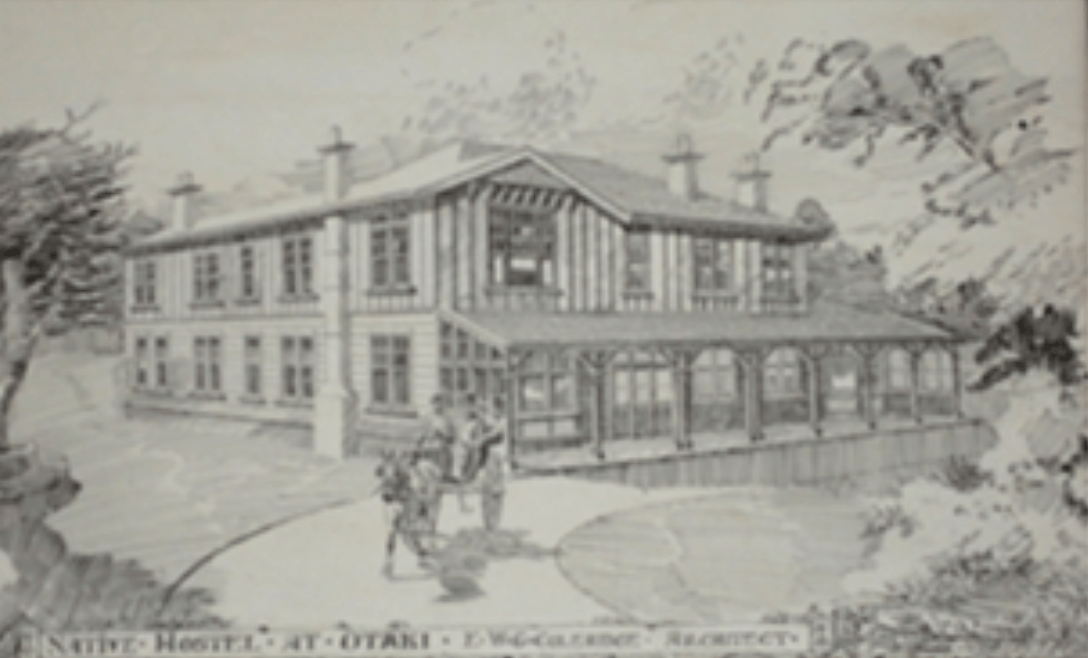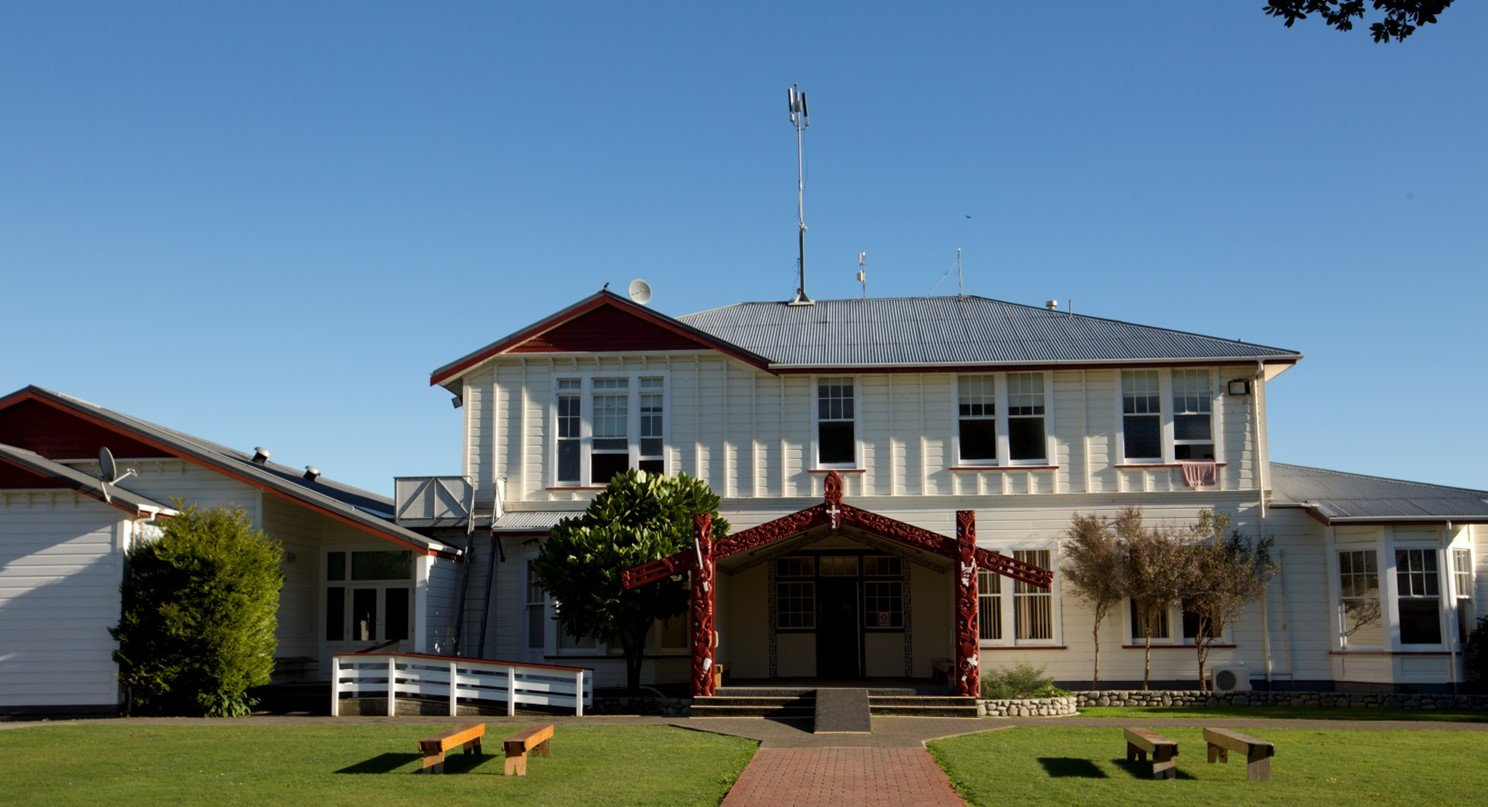History
Establishment of Te Wānanga o Raukawa
Te Wānanga o Raukawa arose from a joint effort of Te Ātiawa ki Whakarongotai, Ngāti Raukawa ki te tonga and Ngāti Toa Rangatira, also known as the ART Confederation.
The following timeline shows some of the key events and milestones leading up to the establishment of Te Wānanga o Raukawa.
- 1850
The first of the major post-European intiatives of the ART Confederation involved the promninent church of the area, Rangiātea. Rangiātea was operational from 1850-1995 when it was consumed by fire and burnt to the ground. A programme of replication was undertaken and the new church building was opened in November 2003.
- 1860
Key joint venture for the three iwi in the establishment of the Ōtaki Māori Racing Club.
- 1900s
At the turn of the century, the Confederation and the Anglican Church built the Ōtaki Māori College on land provided by the Confederation for education. Due to financial difficulties the Anglican leaders closed the school in 1938, after thirty years of operation. During that time the college provided education for many of the youth who were from the Confederation, including the baritone Inia te Wiata. Other youth from outside the Confederation included the Bishop Manuhuia Bennet and the Honourable Ben Couch.
- 1936
ART built their "marae matua" (parent marae), named Raukawa, in Ōtaki. The Native Purposes Act (1936) allowed for the creation of the Raukawa Marea Trustees. This body of sixty-nine trustees represents the iwi and hapū of the Confederation. Accordingly and as a result of their representation the Trustees were tasked with administering the Confederation.
- 1943
Another important venture of the Confederation was the creation of an educational trust board, called the Ōtaki and Porirura Trusts Board, to administer the land that was previously used by and for the Ōtaki Māori College.
- 1975
The Raukawa Marae Trustees began a 25-year tribal development experiment, known as Whakatupuranga Rua Mano - Generation 2000. Te Wānanga o Raukawa was born out of this revival to assist ART to achieve its educational aspirations. The Raukawa Marae Trustees resolved to establish Te Wānanga o Raukawa in April 1981 for the advancement of knowlwdge and fot he dissemination and maintenance of knowledge through teaching and research. The Raukawa Marae Trustees saw Te Wānanga o Raukawa as a natural and necessary extension of Whakatupuranga Rua Mano.
- 1984
Repeated proposals were presented to the Crown in the late seventies and early eighties and only attracted lukewarm responses. Despite this, the development of a wānanga was given top priority by the Raukawa Marae Trustees. Te Wānanga o Raukawa became an incorporated body in 1984.
- 1993
In 1993 Te Wānanga o Raukawa were recognised by the Crown as a "wānanga" under their new legislation knwon as the Education Amendment Act 1990. By this time Te Wānanga o Raukawa had been fully operational for over a decade.
Art Confederation
Mai i Waitapu ki Rangataua, mai i Mīria-te-kakara ki Whitireia, whakawhitia Te Moana o Raukawa, ki Wairau, ki Whakatū.
The ART Confederation is the iwi of Te Ātiawa ki Whakarongotai, Ngāti Raukawa ki te tonga and Ngāti Toa Rangatira. The Confederation has a population of about 40,000. The iwi and hapū of ART are listed below by the towns and districts in which the residences and their marae are concentrated. Representatives of the ART iwi and hapū make up the Raukawa Marae Trustees.
Tokorangi, Halcombe, Bulls, Feilding
- Ngāti Pikiahu
- Ngāti Pikiahu Waewae
- Ngāti Rangatahi Matakore
- Ngāti Manomano
- Ngāti Parewahawaha
- Ngāti Tahuriwakanui
- Ngāti Kauwhata
Himatangi, Foxton, Shannon
- Ngāti Te Au
- Ngāti Tūranga
- Ngāti Rākau
- Ngāti Whakatere
Levin, Ōhau
- Ngāti Ngārongo
- Ngāti Takihiku
- Ngāti Huia ki Poroutāwhao
- Ngāti Huia ki Matau
- Ngāti Pareraukawa
- Ngāti Kikopiri
- Ngāti Tūkorehe
Manakau, Ōtaki
- Ngāti Wehiwehi
- Ngāti Korokī
- Ngāti Maiōtaki
- Ngāti Pare
- Ngāti Kapumanawawhiti
- Ngāti Huia ki Katihiku
Waikanae, Porirua, Wellington
Nelson, Wairau
- Ngāti Toa Rangatira
- Ngāti Koata
- Ngāti Rārua
Establishment of Te Wānanga o Raukawa
Te Wānanga o Raukawa arose from a joint effort of Te Āti Awa ki Whakarongotai, Ngāti Raukawa ki te tonga and Ngāti Toa Rangatira, also known as the ART Confederation.
The following timeline shows some of the key events and milestones leading up to the establishment of Te Wānanga o Raukawa.
-
1850
The first of the major post-European intiatives of the ART Confederation involved the prominent church of the area, Rangiātea. Rangiātea was operational from 1850-1995 when it was consumed by fire and burnt to the ground. A programme of replication was undertaken and the new church building was opened in November 2003.
-
1860
Key joint venture for the three iwi in the establishment of the Ōtaki Māori Racing Club.
-
1900s
At the turn of the century, the Confederation and the Anglican Church built the Ōtaki Māori College on land provided by the Confederation for education. Due to financial difficulties the Anglican leaders closed the school in 1938, after thirty years of operation. During that time the college provided education for many of the youth who were from the Confederation, including the baritone Inia te Wiata. Other youth from outside the Confederation included the Bishop Manuhuia Bennet and the Honourable Ben Couch.
-
1936
ART built their "marae matua" (parent marae), named Raukawa, in Ōtaki. The Native Purposes Act (1936) allowed for the creation of the Raukawa Marae Trustees. This body of sixty-nine trustees represents the iwi and hapū of the Confederation. Accordingly and as a result of their representation the Trustees were tasked with administering the Confederation.
-
1943
Another important venture of the Confederation was the creation of an educational trust board, called the Ōtaki and Porirua Trusts Board, to administer the land that was previously used by and for the Ōtaki Māori College.
-
1975
The Raukawa Marae Trustees began a 25-year tribal development experiment, known as Whakatupuranga Rua Mano - Generation 2000. Te Wānanga o Raukawa was born out of this revival to assist ART to achieve its educational aspirations. The Raukawa Marae Trustees resolved to establish Te Wānanga o Raukawa in April 1981 for the advancement of knowledge and for the dissemination and maintenance of knowledge through teaching and research. The Raukawa Marae Trustees saw Te Wānanga o Raukawa as a natural and necessary extension of Whakatupuranga Rua Mano.
-
1984
Repeated proposals were presented to the Crown in the late seventies and early eighties and only attracted lukewarm responses. Despite this, the development of a wānanga was given top priority by the Raukawa Marae Trustees. Te Wānanga o Raukawa became an incorporated body in 1984.
-
1993
In 1993 Te Wānanga o Raukawa were recognised by the Crown as a "wānanga" under their new legislation known as the Education Amendment Act 1990. By this time Te Wānanga o Raukawa had been fully operational for over a decade.
Art Confederation
Mai i Waitapu ki Rangataua, mai i Mīria-te-kakara ki Whitireia, whakawhitia Te Moana o Raukawa, ki Wairau, ki Whakatū.
The ART Confederation is the iwi of Te Āti Awa ki Whakarongotai, Ngāti Raukawa ki te tonga and Ngāti Toa Rangatira. The Confederation has a population of about 40,000. The iwi and hapū of ART are listed below by the towns and districts in which the residences and their marae are concentrated. Representatives of the ART iwi and hapū make up the Raukawa Marae Trustees.
Tokorangi, Halcombe, Bulls, Feilding
- Ngāti Pikiahu
- Ngāti Pikiahu Waewae
- Ngāti Rangatahi Matakore
- Ngāti Manomano
- Ngāti Parewahawaha
- Ngāti Tahuriwakanui
- Ngāti Kauwhata
Himatangi, Foxton, Shannon
- Ngāti Te Au
- Ngāti Tūranga
- Ngāti Rākau
- Ngāti Whakatere
Levin, Ōhau
- Ngāti Ngārongo
- Ngāti Takihiku
- Ngāti Huia ki Poroutāwhao
- Ngāti Huia ki Matau
- Ngāti Pareraukawa
- Ngāti Kikopiri
- Ngāti Tūkorehe
Manakau, Ōtaki
- Ngāti Wehiwehi
- Ngāti Korokī
- Ngāti Maiōtaki
- Ngāti Pare
- Ngāti Kapumanawawhiti
- Ngāti Huia ki Katihiku
Waikanae, Porirua, Wellington
Nelson, Wairau
- Ngāti Toa Rangatira
- Ngāti Koata
- Ngāti Rārua
144 Tasman Road, Ōtaki, New Zealand 5512
Main Entrance 41 Te Rauparaha Street, Ōtaki, New Zealand 5512
Phone 0800 WANANGA
Reconnect with Māori knowledge
All Rights Reserved | Te Wānanga o Raukawa


